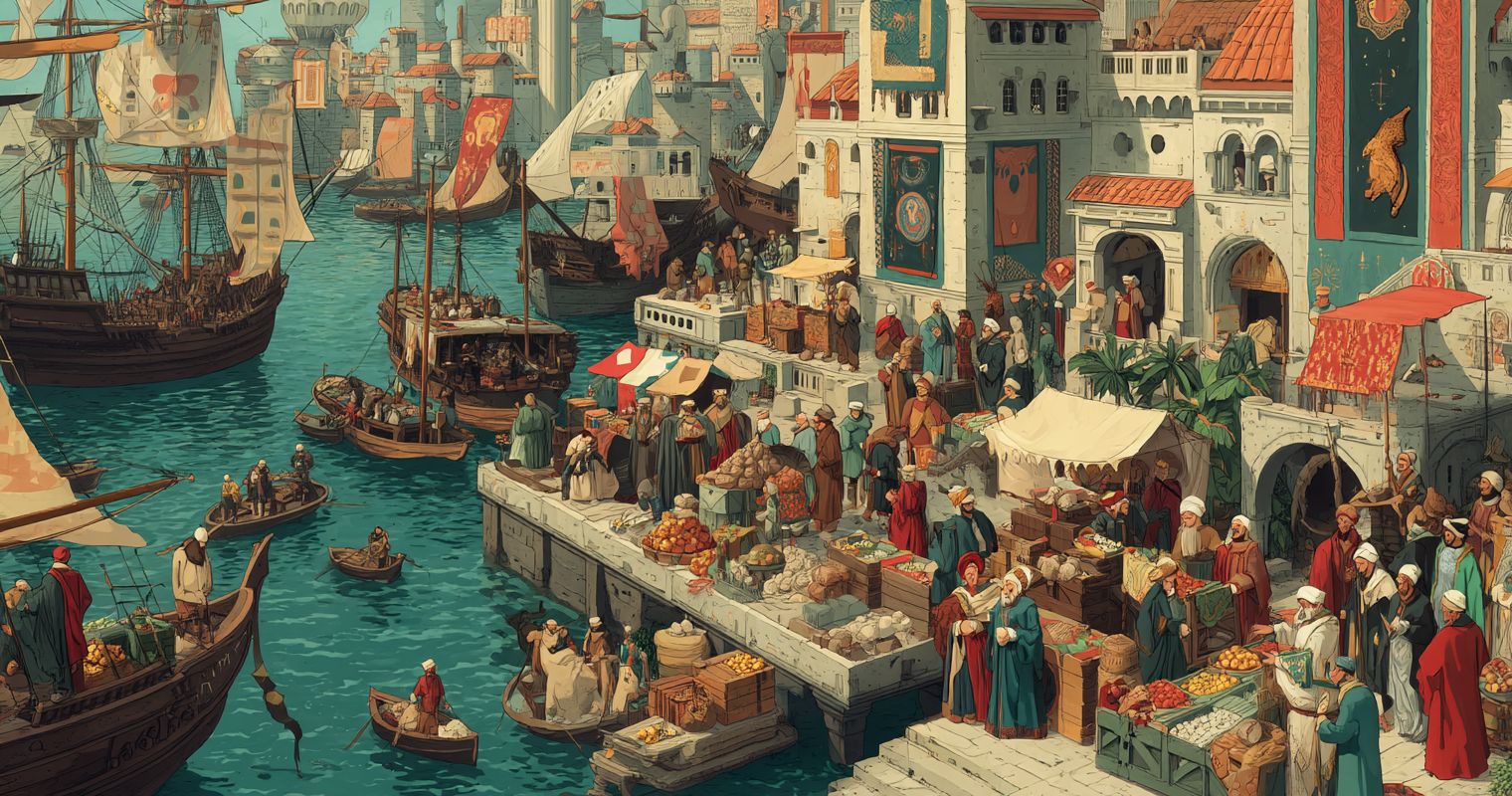Venice rode the waves of Byzantine and Ottoman seas with cunning diplomacy, naval muscle, and slick trade moves — leaving Ottoman guilds tangled in monopoly webs and pricey regulations.
Help out Historygonebananas by visiting our sponsor of today:
Receive Honest News Today
Join over 4 million Americans who start their day with 1440 – your daily digest for unbiased, fact-centric news. From politics to sports, we cover it all by analyzing over 100 sources. Our concise, 5-minute read lands in your inbox each morning at no cost. Experience news without the noise; let 1440 help you make up your own mind. Sign up now and invite your friends and family to be part of the informed.
How Venetian Merchants Outsailed Ottoman Guilds in Mediterranean Trade
Venetian Dominance: From Byzantine Commerce to Ottoman Seas
Venice started out as the friendly middleman in the Byzantine Empire’s bustling markets, snagging privileged trade deals that gave it the best seats at the luxury goods buffet. When the Ottomans stormed Constantinople in 1453, Venice didn’t throw up its hands — it sweet-talked the new rulers, securing treaties ("Capitolazioni") that let Venetian merchants keep their trade perks. It was like switching dance partners smoothly at the empire ball while keeping all the best moves. Venice became the Mediterranean’s trading ninja, ruling key sea routes and ferrying silk, spices, and glass with naval precision.
The Ottoman Guild System: Monopoly Madness or Market Mayhem?
While Venice danced free, Ottoman guilds enforced the "gedik" system — a monopoly game where only the chosen few could make and sell specific goods. Think of it like owning the only banana stand in town but refusing to let anyone else open theirs or try new recipes. With strict quality rules, licensing, and limited newcomers, these guilds prioritized control and tradition over innovation. This cozy little monopoly bubble made the guilds inflexible and slow to respond to changing trade winds.
European Guilds vs Ottoman Guilds: The Great Guild Showdown
European guilds weren’t exactly wild parties either — they set prices and guarded craft secrets. But they tended to be more adaptable, sometimes letting innovation sneak in and playing politics in ways Ottoman guilds wouldn’t dare. The Europeans also enjoyed more autonomy and often expanded their trade networks, making their guilds more responsive to market demands. Ottoman guilds, by contrast, were tightly woven into the Ottoman bureaucracy, resisting change and keeping strict social and professional boundaries.
Why Ottoman Guilds Fell Behind Venice’s Merchant Fleet
Venetian merchants were nimble, flexible, and backed by superior naval power that protected their fleet and commerce. Ottoman guilds, bogged down by rigid monopolies, corruption from license trading, and conservative practices, looked like relics trying to win a sprint while wearing ancient armor. The Ottomans valued military conquest and imperial control more than flexible commerce, leaving trade a slower, less competitive part of their empire’s story. Venice’s savvy diplomacy, advanced shipping tech, and well-oiled merchant networks crushed the Ottoman attempts to dominate Mediterranean trade by sea.
Ottoman Guild Regulations: The Monopoly Trap
The gedik monopoly licenses limited market entry and froze production control tight. No license? No goods on the market. This killed competition, stifled innovation, and gave rise to corruption where licenses could be bought and sold like trading cards. This monopoly trap turned Ottoman trade into a sluggish beast instead of a sleek merchant shark.
European Craft Guilds’ Legal Power Over Prices
European guilds often acted like medieval cartels, legally setting prices and quality standards to keep profits high and competition low. But they were more politically savvy, sometimes flexing these powers to gain influence in city governments and overseas markets. Whereas Ottoman guilds clung to tradition and strict control, European guilds occasionally bent rules to stay ahead in expanding markets, keeping their crafts relevant and competitive.
Lessons for Historians & History Geeks: Trade, Power & Silly Market Rules
For all history buffs and trade nerds, the Venetian vs Ottoman story is a juicy case study in why inflexible market rules and monopolies can sink an empire’s commercial prospects. Apparently, even mighty empires can be totally outplayed by merchants who know how to adapt, negotiate, and, yes, sail like pros. It’s a timeless lesson on the clash of tradition versus innovation, with plenty of hilarious old-school market drama to savor.
Wrap-Up with a Banana-Powered Call to Action!
If you found this historical deep dive as tasty as a ripe banana, peel yourself over to HistoryGoneBananas! Subscribe to our newsletter for more weird and wonderful past tales, follow our socials for your daily dose of history and humor, and help us keep the history banana train rolling. After all, history is way more fun when you add some silliness!
FAQs
Q: What was the Ottoman gedik system?
A: A monopoly licensing system controlling who could produce and sell goods, limiting market competition.
Q: Why did Venetian merchants dominate Ottoman trade?
A: Thanks to smart diplomacy, naval power, and trade flexibility, Venice secured privileged treaties and controlled key Mediterranean routes.
Q: How were European guilds different from Ottoman guilds?
A: European guilds had more autonomy, adapted to market changes quicker, and sometimes influenced politics, unlike more rigid, state-controlled Ottoman guilds.
Q: Did Ottoman guilds set prices like European guilds?
A: Both did, but Ottoman guilds’ controls were tighter, often stifling innovation, while European guilds balanced regulation with market expansion strategies.


